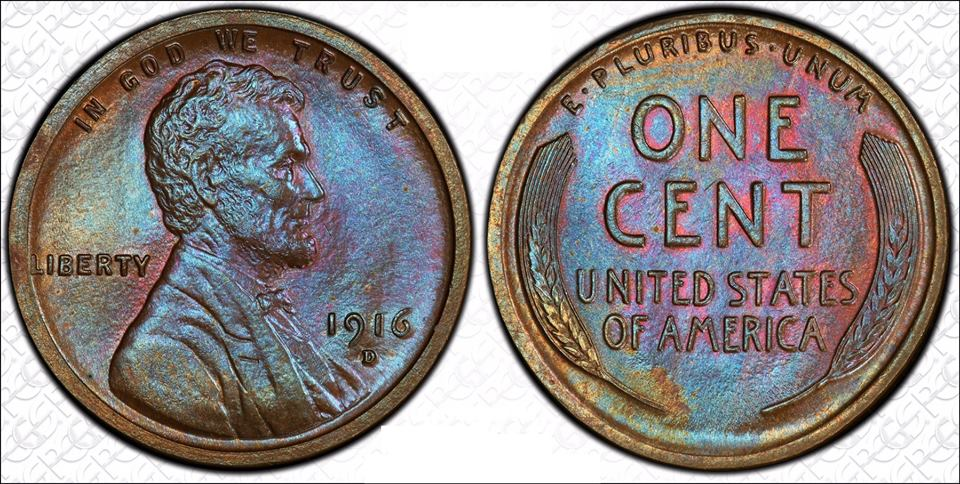Could this 1916 D Lincoln be a matt proof?
 Elemint
Posts: 479 ✭✭✭✭
Elemint
Posts: 479 ✭✭✭✭
Other questions about this coin. 1. Is it AT or NT? 2. What is the grade?

9
 Elemint
Posts: 479 ✭✭✭✭
Elemint
Posts: 479 ✭✭✭✭
Other questions about this coin. 1. Is it AT or NT? 2. What is the grade?

Comments
Not a matte proof - Denver didn't mint any, and the rims are squared up on the lower reverse. May be a specimen strike. As far as AT, hard to tell with lighting used by PCGS.
No. Just a very nice well struck cent.
Worry is the interest you pay on a debt you may not owe.
"Paper money eventually returns to its intrinsic value---zero."----Voltaire
"Everything you say should be true, but not everything true should be said."----Voltaire
The master hub was redesigned in 1916 and that also contributes to marvelously well-struck coins such as the piece here. Great coin!
Kind regards,
George
Nice looking coin, really pleasant color. Tell me it's nt. Peace Roy
BST: endeavor1967, synchr, kliao, Outhaul, Donttellthewife, U1Chicago, ajaan, mCarney1173, SurfinHi, MWallace, Sandman70gt, mustanggt, Pittstate03, Lazybones, Walkerguy21D, coinandcurrency242 , thebigeng, Collectorcoins, JimTyler, USMarine6, Elkevvo, Coll3ctor, Yorkshireman, CUKevin, ranshdow, CoinHunter4, bennybravo, Centsearcher, braddick, Windycity, ZoidMeister, mirabela, JJM, RichURich, Bullsitter, jmski52, LukeMarshall, coinsarefun, MichaelDixon, NickPatton, ProfLiz, Twobitcollector,Jesbroken oih82w8, DCW
No proofs from the Denver mint but those really wide rims are somewhat unusual, similar to matte proofs, but it's not one.
That is an impressive cent....The wide rims look unusual.....Cheers, RickO
Nice coin!
Looks NT to me. Pcgs graded it Genuine / Damaged due to reverse rim wierdness. Should have graded ms66bn imho.
My Coin Blog
My Toned Lincoln Registry Set
Is it possible that the rim damage was made during the minting process and is not PMD? The damage looks as old as the coin. Could this be considered a mint error and as such be graded?
BTW, I will add that this is from the TrueView of the OP’s 1916-D and the reason it did not grade.
- Bob -

MPL's - Lincolns of Color
Central Valley Roosevelts
Probably toned out in album. MS65 BN range. Nice strike. Nothing unusual to me- jmo.
It is not an early die state. For example, it has wavy fields and there is ghosting on the "6" due to die erosion (from striking a lot of coins). I think any specimen or proof striking (if any were made) would be an early die state.
The color doesn't look too wild or off to me so I would say NT and 65BN. The wide rims are unusual and generally when I've seen wide rims like that there is an extra line around the rim that some describe as a "wire rim" but this one doesn't have that.
I'm wondering if the wide rims could be due to an irregular sized planchet? (This is just a guess as I have a lot to learn about the minting process...)
Nice coin . Love the beard and hair detail!
I might be wrong but I assume the collar makes sure the planchet size ends up being consistent when the coin is struck.
No idea why it has that great wide rim.
This coin illustrates in spades that craftsmanship is truly a lost art in terms of coinage produced today.
Experience the World through Numismatics...it's more than you can imagine.
What error? Crumpled rim? I mean, not every bad thing that happens in the minting process is a certifiable error. Sometimes a poorly formed rim is just a cigar..or a penis.
All comments reflect the opinion of the author, even when irrefutably accurate.
If they can certify scrap metal scrapped up from the floor why not certify something that may have had a planchet defect? Or something damaged before it left the mint?
- Bob -

MPL's - Lincolns of Color
Central Valley Roosevelts
They also don't certify mint employee finger prints as errors, or random scratches, etc. They can certify anything. In fact, they want to certify everything, they get paid for it. But that doesn't mean they should or that it is an error anyone would care about.
All comments reflect the opinion of the author, even when irrefutably accurate.
It could have been the result of a rim cud that broke off during the pressure of striking.
- Bob -

MPL's - Lincolns of Color
Central Valley Roosevelts
Good to know.
- Bob -

MPL's - Lincolns of Color
Central Valley Roosevelts
There would be nothing wrong with calling this coin matte proof-like.
a.k.a "The BUFFINATOR"
RE: "Could this 1916 D Lincoln be a matt proof?"
No. It is within the range of normal coining from circulation dies. Very nice coin.
Hi @Elemint,
I bought this coin raw from ebay about four or five years ago, if my memory serves me. I attempted two or three times to grade it with PCGS (See attached files).
Each time it graded some form of "damage" (98). Then I gave up and sold it. I can't remember if I called PCGS to ask them if there were grader notes, but I remember being told the coin has a finned rim, which was a new term to me which means it has a "fin" of extra metal emanating from a portion of the rim. Not sure what to do with it, I sold it. It's absolutely gorgeous in hand and if the new owner got it in a holder that makes me very happy.